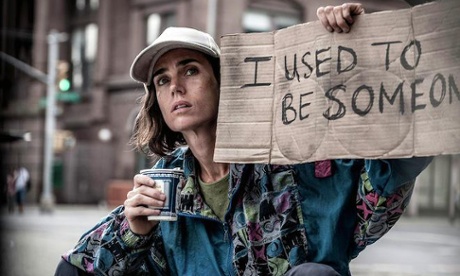
Paul Bettany’s first film as both writer and director ends with a dedication: “To the couple who lived outside my building.” You only pray that his story isn’t based too closely on their experience. If so, they are the most tragic, least fortunate couple in history.
Hannah (Jennifer Connelly, who is married to Bettany) has lived on the streets of New York since her husband died. She’s addicted to heroin and is considering suicide until she meets Tahir (Anthony Mackie), an illegal immigrant from Lagos. The two fall into dependence that turns into love. Tahir can give Hannah the strength to attempt a recovery. Hannah can offer Tahir redemption for a terrible crime in his past.
Bettany works his own script into a studenty weepy that pushes everything way too far. After a promising opening, the film spins off into melodrama. Bettany employs his cinematographer, Paula Huidobro (Arthur and Mike) to make New York look depressing. Hannah and Tahir walk through streets in various hues of grey, dank grey, dirt grey and sludge. They talk about God (Tahir believes, Hannah doesn’t) and drugs (Hannah believes, Tahir doesn’t) in a way that screams of a well-meaning, well-off person addressing social ills. Hannah questions the existence of a God who has chosen to abandon them. Tahir, who pops along to his imam for a bit of potted wisdom now and then, tells her not to question His ways. It’s not a particularly original or watchable debate.
The film becomes romantic, tragic and miserable, a worst-case-scenario flick that – partly due to casting, mainly due to tone – can’t avoid comparisons with Darren Aronofsky’s similarly bleak Requiem for a Dream. Connelly gives a typically raw performance as a grief-wracked drug addict. Mackie, who struggles both with a weak part and his Nigerian accent, can offer no foil. The film tips firmly into Hannah’s favour. It becomes a Connelly showcase: overwrought and mildly unbelievable.
Hannah and Tahir take up in a loft apartment left unguarded during the summer holidays. They crack into the owner’s wine, cook a chicken and dress up in bourgeois finery. Hannah wears an elegant dress that clings to her gaunt body. The track marks show through the thin fabric. “I must look like a zombie goldilocks”, she says. It’s a little bit of light at last, but Bettany snuffs it out quickly. After the chicken comes the cold turkey, with Hannah puking and screaming amid the opulence. Her resolve comes crashing down in a viscerally nasty scene in which she shoots up into a vein in her crotch. Tahir looks on in despair. Us too.
There’s no community around Hannah and Tahir, so we’ve got no context in which to place their suffering. They are homeless people who weather the extreme worst of what can happen, experiencing sexual assault, drug dependence, imprisonment and crippling grief. There’s no doubt that real life on the street can be dangerous and miserable, but there’s little allowance for the possibility that the homeless community might also occasionally experience laughter, joy or a sense of optimism. Perhaps, even, the odd bit of mindless fun. The focus of the film is so narrow, the couple’s lives so improbably anguished, that they lose your sympathy and strain for your pity.
Hannah crouches and sets up her stall: a coffee cup for change and a worn cardboard sign: “I USED TO BE SOMEONE”. The sign is representative. The film likewise progresses from striking to morbid to melodramatic and false.

